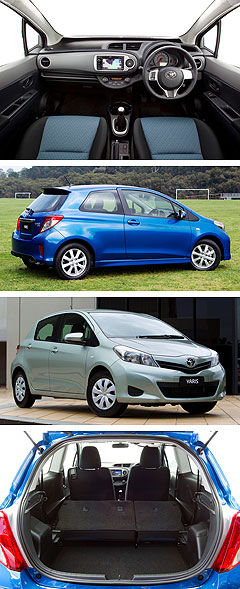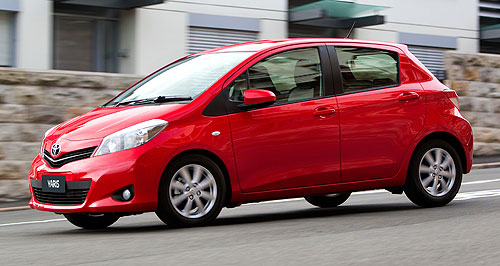Make / Model Search
News - Toyota - YarisEuro vision for Toyota’s new YarisEurasian: The 130-series Yaris is the first generation of the Euro-focused light car to be styled in Japan, but most aspects of its development honed in on the European market. Toyota’s new light car was developed with European focus, despite Japanese styling26 Oct 2011 TOYOTA has revealed that its third-generation XP130-series Yaris just launched in Australia was engineered primarily to appeal to European buyers affected by a post-GFC economic environment. Key targets included lower emissions, heightened road presence, improved dynamics and a better quality and more spacious interior, combined with increased safety, greater value for money and a more gender-neutral look, as the last one was deemed too feminine. However, with millions of the first-generation XP10 (sold as the Echo in Australia) and follow-up XP90 Yaris hatchbacks sold across Europe since 1999, the Japanese car-maker was also keen to preserve the outgoing models’ key attributes of ‘piccolo genius’ packaging, a compact footprint, low running costs, ease of driving and reliability. Speaking to GoAuto at the Australian launch of the XP130 Yaris this week, chief engineer Hirofumi Yamamoto emphasised how ‘European’ the new model is compared to its Toyota stablemates. He said four four key German and French rivals were benchmarked during development, which occurred over 38 months at Toyota’s new $60 million research and development centre in Belgium, and involved more than 2000 people. “We listened to over 1000 current owners from all over Europe, as well as Japan and Australia, to find how we can improve the new Yaris,” Mr Yamamoto said. Among the rival hatchbacks on board during the XP130’s development were the current Ford Fiesta, Peugeot 207, Volkswagen Polo and Renault Clio. Perhaps surprisingly (except to their satisfied owners), the French models were deemed the most desirable for achieving a harmonious balance between agility, comfort, refinement and quietness. “We considered different aspects from each car because some have stronger points than others,” Mr Yamamoto said.  Beefing up the body rigidity for improved steering and handling qualities, as well as cutting noise and vibration paths, reducing weight, improving aerodynamic flow and achieving better pedestrian impact results were paramount in achieving Toyota’s goals for the new Yaris. Beefing up the body rigidity for improved steering and handling qualities, as well as cutting noise and vibration paths, reducing weight, improving aerodynamic flow and achieving better pedestrian impact results were paramount in achieving Toyota’s goals for the new Yaris.Among the solutions was a rise in the use of high-tensile steel, increasing to 53 per cent, and going from a twin to single arm windscreen wiper system. The latter saves weight and also improves the vehicle’s level of pedestrian protection. Interestingly, the Australian-spec Yaris misses out on the underbody flow panels that help drop the Euro XP130’s drag coefficient down from an improved 0.30Cd to an impressive 0.286. The outgoing model was rated at 0.31Cd. Another feature destined only for European and Japanese markets is the CVT continuously variable transmission in lieu of the now-outmoded four-speed automatic gearbox that Australian XP130s receive. Mr Yamamoto said there was plenty of debate within the company about the use of the CVT, which serves to cut fuel consumption and emissions to better-than-manual gearbox levels but has the drawback of less mid-range responsiveness compared to torque-converter or dual-clutch alternatives. “There was much discussion with CVT,” he said. “It is still a gamble. It is being tried out in Europe to see if it is successful. But with CVT here is lower fuel consumption, and lower emissions … greater than a 10 per cent saving.” The Japanese engineer believes Australian and North American distances, as well as driver habits, better suit the four-speed auto. He also dismissed a dual-clutch gearbox option for Yaris in the foreseeable future, saying it would add considerable complexity and expense in a price-sensitive end of the market – particularly when a CVT is just as effective in lowering CO2 emissions. With the new model’s styling, several Toyota design departments from around the world pitched for the prize of creating the latest Yaris’ look, with one of the Japanese proposals winning out for the first time since the Starlet days of the 1990s. The previous versions were the work of the company’s ED2 studio in France. “We wanted to increase the presence on the road (to attract new buyers),” chief designer Takeshi Go told GoAuto, adding that keeping the same general proportions in a roomier package was also essential in satisfying the existing customer base. “We also wanted to maintain the ‘small’ proportions and ‘piccolo genio’ (Italian for ‘small genius’) ways of the previous generations. We did not want the Yaris to conform with the rest of the B-segment in Europe.” Mr Go, who oversaw the interior as well as exterior elements of XP130, cites the more animalistic headlight treatment as key to giving the Yaris a more aggressive and standout look on the road. Mr Go nominated the pronounced shoulder line, combined with the crisp yet soft surfacing interplay around the rear wheelarch, as his favourite aspects of the exterior. “It says compact but also gives the car a richness,” he said. While praising the higher quality trim and ‘cockpit’-style fascia arrangement, Mr Go defended the abandonment of the previous Yaris’ centralised digital information binnacle and storage spaces that came with it, for a far more conventional analogue item positioned directly ahead of the driver. “In Europe they hated the dash of the old Yaris, and all the shutlines,” he revealed, referring to the glovebox lids that proliferated on either side of the console. “And for people downsizing in to the Yaris from larger cars, they found the central speedo a bit too cheap and downmarket for them.” The designer also mentioned that the previous models’ vertical heater controls were positioned too far for ease of use during night-time driving, while the high number of buyers ordering Toyota-genuine or aftermarket satellite-navigation systems in Europe and Japan meant that provisions for a screen were necessary for the newcomer. Other plus points that Mr Go mentioned included the ‘walk-in’ quick-release passenger seat that facilitates rear entry and exit in the three-door hatch versions, as well as the better-positioned and improved ergonomics of the steering wheel.  Read more25th of October 2011  First drive: Toyota reloads with all-new YarisNew-gen Yaris adds value, space and safety as Toyota mounts fresh light-car attack8th of August 2011  New Yaris gets localisedAustralian technical centre tunes Yaris for local tastes ahead of October launch14th of July 2011  Europe set, Oz waits for all-new YarisAussie launch timing still unclear as Toyota reveals full details of new Euro Yaris |
Click to shareToyota articlesResearch Toyota Yaris pricingMotor industry news |











Facebook Twitter Instagram